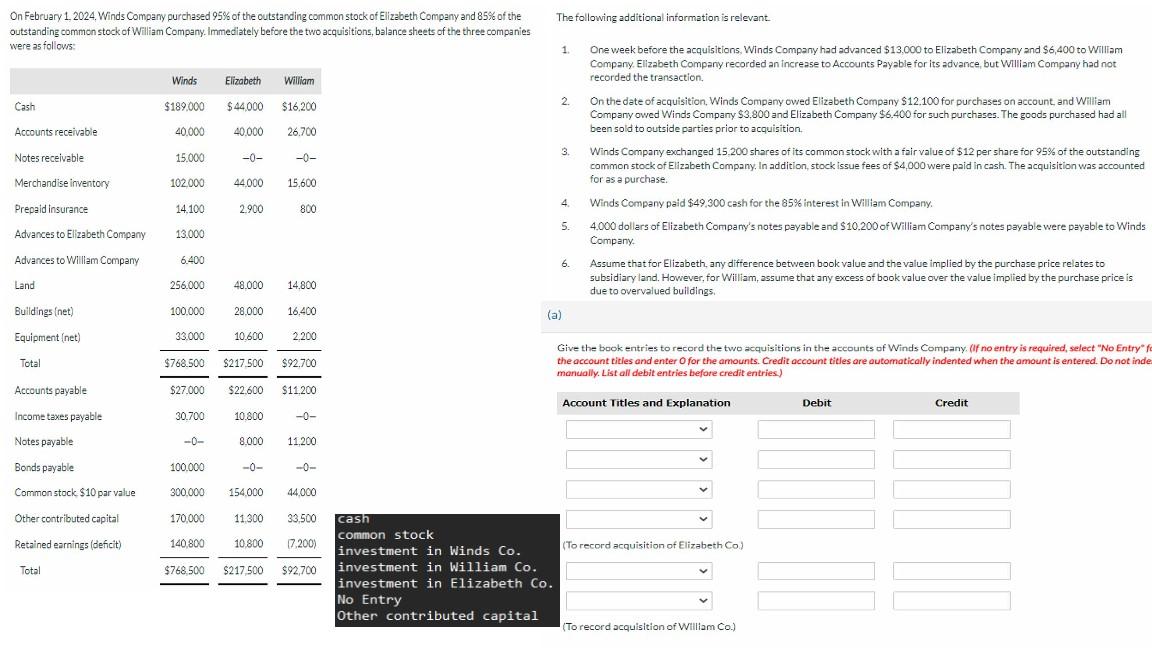Answered step by step
Verified Expert Solution
Question
1 Approved Answer
On February 1, 2024, Winds Company purchased 95% of the outstanding common stock of Elizabeth Company and 85% of the outstanding common stock of

On February 1, 2024, Winds Company purchased 95% of the outstanding common stock of Elizabeth Company and 85% of the outstanding common stock of William Company. Immediately before the two acquisitions, balance sheets of the three companies were as follows: Cash Accounts receivable Notes receivable Merchandise inventory Prepaid insurance Advances to Elizabeth Company Advances to William Company Land Buildings (net) Equipment (net) Total Accounts payable Income taxes payable Notes payable Bonds payable Common stock $10 par value Other contributed capital Retained earnings (deficit) Total Winds $189.000 40,000 15.000 102.000 14,100 13.000 6.400 256.000 100.000 33.000 $768.500 100,000 William $44.000 $16,200 40,000 26.700 -0- 44.000 15,600 800 300,000 170,000 140,800 Elizabeth -0- 2.900 48.000 14.800 28.000 16.400 $27.000 $22.600 30.700 -0- 10.600 $217.500 $92.700 $11.200 -0- 10.800 8,000 11.200 -0- 2.200 154,000 44,000 11.300 33.500 10,800 (7,200) $92,700 $768,500 $217.500 cash common stock The following additional information is relevant. investment in Winds Co. investment in William Co. investment in Elizabeth Co. No Entry Other contributed capital 1. 2. (a) 3. 4. 5. 6. One week before the acquisitions, Winds Company had advanced $13,000 to Elizabeth Company and $6,400 to William Company. Elizabeth Company recorded an increase to Accounts Payable for its advance, but William Company had not recorded the transaction. On the date of acquisition, Winds Company owed Elizabeth Company $12.100 for purchases on account, and William Company owed Winds Company $3,800 and Elizabeth Company $6.400 for such purchases. The goods purchased had all been sold to outside parties prior to acquisition. Winds Company exchanged 15.200 shares of its common stock with a fair value of $12 per share for 95% of the outstanding common stock of Elizabeth Company. In addition, stock issue fees of $4,000 were paid in cash. The acquisition was accounted for as a purchase. Winds Company paid $49.300 cash for the 85% interest in William Company. 4.000 dollars of Elizabeth Company's notes payable and $10.200 of William Company's notes payable were payable to Winds Company. Assume that for Elizabeth, any difference between book value and the value implied by the purchase price relates to subsidiary land. However, for William, assume that any excess of book value over the value implied by the purchase price is due to overvalued buildings. Give the book entries to record the two acquisitions in the accounts of Winds Company. (If no entry is required, select "No Entry" fo the account titles and enter O for the amounts. Credit account titles are automatically indented when the amount is entered. Do not inder manually. List all debit entries before credit entries.) Account Titles and Explanation (To record acquisition of Elizabeth Co.) (To record acquisition of William Co.) Debit Credit
Step by Step Solution
★★★★★
3.47 Rating (150 Votes )
There are 3 Steps involved in it
Step: 1
SOLUTION Based on the information provided the book entries to record the two acquisitions in the ac...
Get Instant Access to Expert-Tailored Solutions
See step-by-step solutions with expert insights and AI powered tools for academic success
Step: 2

Step: 3

Ace Your Homework with AI
Get the answers you need in no time with our AI-driven, step-by-step assistance
Get Started


